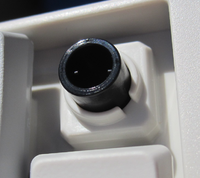Rubber dome
Revision as of 01:59, 1 October 2012 by Daniel beardsmore (talk | contribs) (Switched to definition lists for clarity and semantics)
This article is a stub. You can help Deskthority by expanding it.
Rubber dome is a type of keyboard switching technology that is most commonly used on modern keyboards, using collapsible rubber domes to provide resistance and tactility to keys. Most rubber dome keyboards use a membrane contact sheet below the dome to provide electrical switching, but certain rubber dome switches, such as Topre switches, use capacitive switching.
Contact mechanism
Dome switch keyboards use several contact mechanisms:
- Membrane
- The "ceiling" of the dome presses two plastic membranes together to connect circuit traces
- Membrane with carbon-coated domes
- The ceiling of the dome is coated with carbon, and this conductive layer connects a pair of circuit traces together when it makes contact with the membrane
- Capacitive
- Topre Realforce keyboards use the rubber dome solely as a spring, and switch actuation is performed using capacitance via a 5 cN spring compressed by the dome
Varieties
- Plain rubber dome
- A stem is moulded into the keycap that pushes down on the dome; this is the most common variety
- Domes with sliders
- Similar to a microswitch mechanical, each switch contains its own slider that presses on the dome, onto which the keycap is mounted; on some keyboards the slider has a standard U mount or Z mount interface and the board will accept keycaps from mechanical keyboards and donate keycaps for mechanical boards. Dome switches with sliders are now uncommon, but this is the form taken by Topre switches
- Scissors
- Laptop keyboards introduced the use of scissor-like mechanisms to stabilise low travel switches that lack a shaft for the keycap to slide inside
